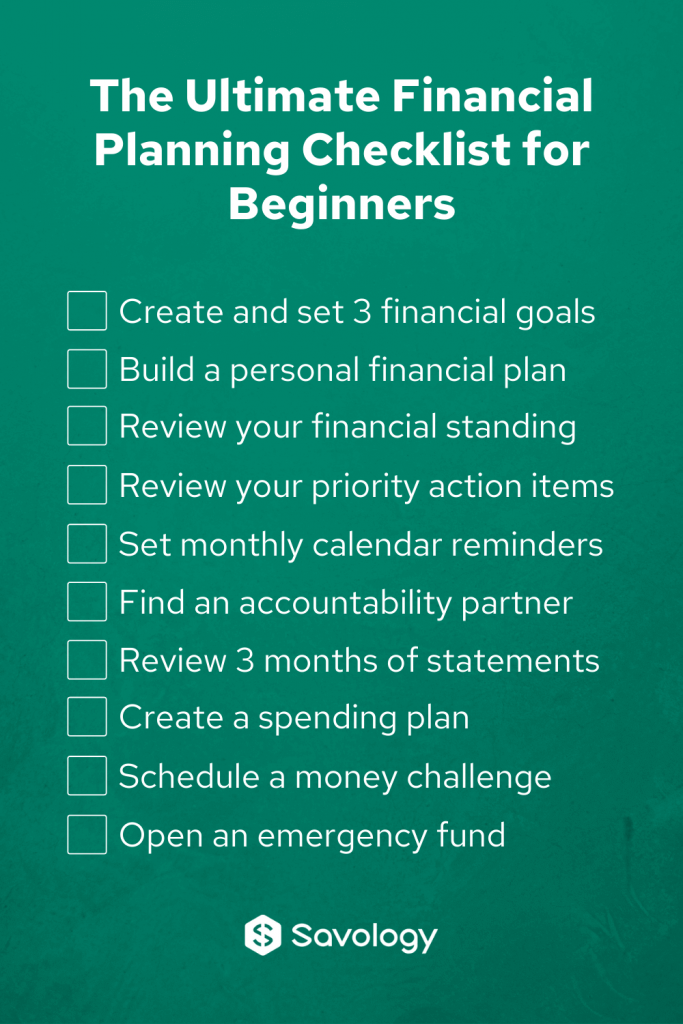Let’s face it—knowing what steps to take with your money and when to take them can feel challenging.
That’s where checklists can be helpful—they can serve as a great way to get small, or big, things done step-by-step while tracking your progress along the way.
To help you get over the feeling of being stuck or any financial stress that you’re enduring, we decided to create a financial checklist to help you with making those first critical steps and getting started on your financial journey.
We’ve also created a downloadable version of the checklist at the very bottom of this article so that you can save it to your computer, print it out, and use it as a reference while you work on each item.
Checklist item #1: Set your financial goals
Before you even consider to start making any type of financial move, the best thing you can do is get clarity on where you want to be by setting financial goals.
When you work on your financial goals, it’s important that you’re setting both long-term and short-term financial goals.
You can think of your long-term financial goals as the larger, significant financial outcomes you want to achieve. Examples might include retiring by the age of 60, owning a time-share or vacation property overseas, or even paying off all of your consumer debt, including student loans.
Your short-term financial goals on the other hand are typically smaller goals that play a role in keeping you motivated and progressing towards your long-term goals. Things like opening a retirement account with automated monthly contributions of $100, building an emergency fund to 1 month’s worth of expenses, and paying off one credit card are all types of short-term goals.
I’d recommend setting three long-term financial goals, and three short-term financial goals to get you started.
Checklist item #2: Build a financial plan
Long gone are the days where a financial plan was regarded as a “nice-to-have” financial tool. It’s now recognized for its importance as an absolute must-have.
In fact, a financial plan is arguably the most important financial tool that you’ll ever have.
Not to mention that if you’re serious about reaching those financial goals mentioned above, you’ll want to make sure you spend time building a financial plan that helps you map out exactly how you’ll reach those goals.
Thankfully, largely in part due to technology, getting a financial plan is no longer a long, cumbersome, and expensive thing to do. With Savology, you can actually get started by building a financial plan in as little as five minutes.
Checklist item #3: Review your current financial standing
Once you’ve set your goals and created your financial plan or blueprint, getting a better understanding of your current financial situation becomes much easier.
Building your financial plan requires you to provide particular information about your financial life which will include things such as how much money you’re making, how much money you’re saving monthly, the types of savings and retirement accounts you have, account balances for each, what your debt situation looks like, the types of insurance coverage and coverage amounts, and much more.
All of this information will help you produce an accurate snapshot of where you currently are to determine the gaps you need to fill in to get to where you want to be. As you review your financial situation, you may discover that you’re doing much better, or worse, in some areas than you expected. This provides you with a much better sense of how you’re currently doing and what you should be focusing on next.
Checklist item #4: Determine what you can do right away to improve
This step involves taking #3 to the next level. In order to see this one through, you’ll want to review each area of your finances in detail so that you determine what’s missing, what needs improving, and exactly how you can bridge the gap between your goals and current situation.
Generally speaking, you will want to pay particular attention to, and start addressing the areas that have the largest gap and that also will end up having the biggest impact on your future.
This is one of the many areas that we’ve focused a lot on here at Savology by providing action items which serve as personalized recommendations. These action items show you the next steps you need to take, how to take them, as well as why you should be taking them so that you have a better understanding all around.
Checklist item #5: Set a calendar reminder to review and audit your finances
While this might sound out of the ordinary, or even unnecessary, I can tell you with confidence from personal experience that it is an absolute game-changer.
Unfortunately, the majority of us are reactive with our finances and do not adopt a proactive mindset. For most, building a financial plan or taking any sort of action is typically a set it and forget it approach.
Being reactive with our finances means that we’re essentially always playing catch-up and spending time re-aligning our goals and financial situations to where we want to be. Which ends up being counterintuitive and productive.
Becoming proactive is all about building better financial habits.
Here’s what I want you to do right now, which you’ll thank me later for doing.
- Go into your personal calendar, open up a new event and create a recurring monthly item for yourself to review and update your financial plan.
- If you have an accountability partner or a spouse that you work on your finances with, add them to the calendar.
- Make sure to set a reminder so that you get the notification multiple times if needed.
- Add this as the name of the event: Review personal financial progress.
- Add this into the event description: Review my financial plan at savology.com and review my important action items to work on.
If you have specific things that you are planning on working on ahead of time then feel free to add those into the calendar. At the end of the day, the more prepared and proactive you can be, the more likely you will be to follow through with taking those steps.
Checklist item #6: Find an accountability partner
Take this for what it’s worth, but in my honest opinion, having an accountability partner is one of the most underutilized and underestimated “resources” you’ll ever have for your money.
An accountability partner is exactly what it sounds like, someone who is working with you to hold you accountable for making financial progress and vice versa. This individual can be a partner, family member, or even a close friend.
At the end of the day, it’s important to make sure that your accountability partner is someone you can trust and rely on when it comes to sharing personal and sensitive financial information. Making sure that there is open communication and frequent check-ins or times to work on your finances together is one of the critical parts of this being successful.
Checklist item #7: Review 3 months of bank statements
If you’re just getting started with your finances, or if you’re looking for more clarity then this is a very good exercise.
Consider taking a look at and reviewing the three previous months of your bank statements. If you have multiple bank accounts, you’ll want to make sure to include all of them and break them out by account.
Don’t hold back here as you’ll want to review and take note of everything from your credit cards and loan accounts to your checking and savings accounts.
Checklist item #8: Create a spending plan
After you’ve had a chance to review your bank account statements, create a spreadsheet or a document where you can start labeling things one by one.
You’ll want to make sure that you have two primary categories: inflow and outflow. Then you’ll want to categorize within both of those so that you can start bucketing items from your bank statement into their respective categories.
The ultimate goal here is to assess your overall money habits and determine what types of expenses (and even income sources) you should keep and what you can or should remove entirely.
If you’re feeling a little stuck, consider using Savology’s monthly budget calculator to take a quick snapshot of your current monthly budget to determine whether or not you’re living within or outside of your means.
Checklist item #9: Create or schedule a money challenge
Money challenges can be a fun, yet extremely impactful way to get motivated and make significant financial improvements.
Money challenges are typically tied to some sort of financial goal and are often a great way to help just about anyone ditch the bad habits and reinforce the good ones.
Most people tend to refer to things like a no-spend month when they think of these challenges, however, there are several different fun money challenges that you can do both alone and with someone like your accountability partner to keep things fresh and exciting. In fact, this 52-week money challenge can help you save more than $5,000 this year alone.
Checklist item #10: Open or increase your emergency fund
Last but not least, you’ll want to either open an emergency fund if you do not have one yet or work on increasing yours if you do.
An adequate emergency fund isn’t just something that’s a nice consideration, it’s actually critical for your overall financial success.
Unfortunately, 2020 and up until now has been a wake-up call for many Americans, leaving many without emergency funds in a very vulnerable and difficult situation, financially. The global pandemic and recessionary period have highlighted the importance of an emergency fund that essentially helps you eliminate future financial risk and hardships.
Start putting your financial checklist to use
By now, you should have a good understanding of ten items that you can start working on right away to either begin your financial journey or to continue making progress on the one you’ve recently started. The next and most critical step is actually working on those items.
Use the above as a guide as you work through the checklist. You can also download and print the image below to check off items as you complete them.








